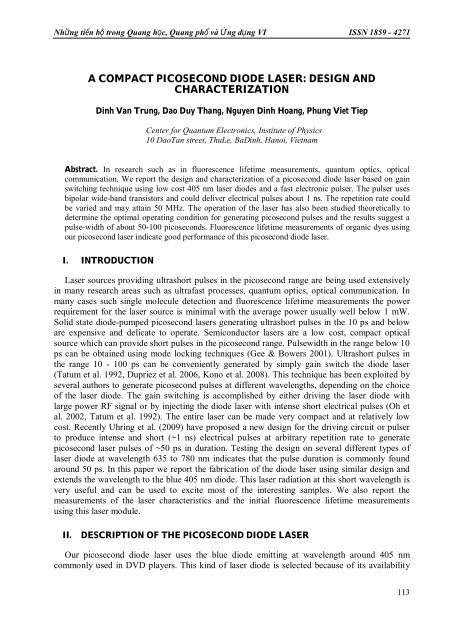Nhng tin b trong Quang hc, Quang ph và ng dng VI ISSN 1859 - 4271
Nhng tin b trong Quang hc, Quang ph và ng dng VI ISSN 1859 - 4271
Nhng tin b trong Quang hc, Quang ph và ng dng VI ISSN 1859 - 4271
Create successful ePaper yourself
Turn your PDF publications into a flip-book with our unique Google optimized e-Paper software.
Nhữ<strong>ng</strong> tiến bộ <stro<strong>ng</strong>>tro<strong>ng</strong></stro<strong>ng</strong>> <stro<strong>ng</strong>>Qua<strong>ng</strong></stro<strong>ng</strong>> học, <stro<strong>ng</strong>>Qua<strong>ng</strong></stro<strong>ng</strong>> <stro<strong>ng</strong>>ph</stro<strong>ng</strong>>ổ và Ứ<strong>ng</strong> dụ<strong>ng</strong> <strong>VI</strong> <strong>ISSN</strong> <strong>1859</strong> - <strong>4271</strong>A COMPACT PICOSECOND DIODE LASER: DESIGN ANDCHARACTERIZATIONDinh Van Tru<strong>ng</strong>, Dao Duy Tha<strong>ng</strong>, Nguyen Dinh Hoa<strong>ng</strong>, Phu<strong>ng</strong> Viet TiepCenter for Quantum Electronics, Institute of Physics10 DaoTan street, ThuLe, BaDinh, Hanoi, VietnamAbstract. In research such as in fluorescence lifetime measurements, quantum optics, opticalcommunication. We report the design and characterization of a picosecond diode laser based on gainswitchi<strong>ng</strong> technique usi<strong>ng</strong> low cost 405 nm laser diodes and a fast electronic pulser. The pulser usesbipolar wide-band transistors and could deliver electrical pulses about 1 ns. The repetition rate couldbe varied and may attain 50 MHz. The operation of the laser has also been studied theoretically todetermine the optimal opera<s<stro<strong>ng</strong>>tro<strong>ng</strong></stro<strong>ng</strong>>>tin</s<stro<strong>ng</strong>>tro<strong>ng</strong></stro<strong>ng</strong>>>g condition for genera<s<stro<strong>ng</strong>>tro<strong>ng</strong></stro<strong>ng</strong>>>tin</s<stro<strong>ng</strong>>tro<strong>ng</strong></stro<strong>ng</strong>>>g picosecond pulses and the results suggest apulse-width of about 50-100 picoseconds. Fluorescence lifetime measurements of organic dyes usi<strong>ng</strong>our picosecond laser indicate good performance of this picosecond diode laser.I. INTRODUCTIONLaser sources providi<strong>ng</strong> ultrashort pulses in the picosecond ra<strong>ng</strong>e are bei<strong>ng</strong> used extensivelyin many research areas such as ultrafast processes, quantum optics, optical communication. Inmany cases such si<strong>ng</strong>le molecule detection and fluorescence lifetime measurements the powerrequirement for the laser source is minimal with the average power usually well below 1 mW.Solid state diode-pumped picosecond lasers genera<s<stro<strong>ng</strong>>tro<strong>ng</strong></stro<strong>ng</strong>>>tin</s<stro<strong>ng</strong>>tro<strong>ng</strong></stro<strong>ng</strong>>>g ultrashort pulses in the 10 ps and beloware expensive and delicate to operate. Semiconductor lasers are a low cost, compact opticalsource which can provide short pulses in the picosecond ra<strong>ng</strong>e. Pulsewidth in the ra<strong>ng</strong>e below 10ps can be obtained usi<strong>ng</strong> mode locki<strong>ng</strong> techniques (Gee & Bowers 2001). Ultrashort pulses inthe ra<strong>ng</strong>e 10 - 100 ps can be conveniently generated by simply gain switch the diode laser(Tatum et al. 1992, Dupriez et al. 2006, Kono et al. 2008). This technique has been exploited byseveral authors to generate picosecond pulses at different wavele<strong>ng</strong>ths, dependi<strong>ng</strong> on the choiceof the laser diode. The gain switchi<strong>ng</strong> is accomplished by either drivi<strong>ng</strong> the laser diode withlarge power RF signal or by injec<s<stro<strong>ng</strong>>tro<strong>ng</strong></stro<strong>ng</strong>>>tin</s<stro<strong>ng</strong>>tro<strong>ng</strong></stro<strong>ng</strong>>>g the diode laser with intense short electrical pulses (Oh etal. 2002, Tatum et al. 1992). The entire laser can be made very compact and at relatively lowcost. Recently Uhri<strong>ng</strong> et al. (2009) have proposed a new design for the drivi<strong>ng</strong> circuit or pulserto produce intense and short (~1 ns) electrical pulses at arbitrary repetition rate to generatepicosecond laser pulses of ~50 ps in duration. Tes<s<stro<strong>ng</strong>>tro<strong>ng</strong></stro<strong>ng</strong>>>tin</s<stro<strong>ng</strong>>tro<strong>ng</strong></stro<strong>ng</strong>>>g the design on several different types oflaser diode at wavele<strong>ng</strong>th 635 to 780 nm indicates that the pulse duration is commonly foundaround 50 ps. In this paper we report the fabrication of the diode laser usi<strong>ng</strong> similar design andextends the wavele<strong>ng</strong>th to the blue 405 nm diode. This laser radiation at this short wavele<strong>ng</strong>th isvery useful and can be used to excite most of the interes<s<stro<strong>ng</strong>>tro<strong>ng</strong></stro<strong>ng</strong>>>tin</s<stro<strong>ng</strong>>tro<strong>ng</strong></stro<strong>ng</strong>>>g samples. We also report themeasurements of the laser characteristics and the initial fluorescence lifetime measurementsusi<strong>ng</strong> this laser module.II. DESCRIPTION OF THE PICOSECOND DIODE LASEROur picosecond diode laser uses the blue diode emit<s<stro<strong>ng</strong>>tro<strong>ng</strong></stro<strong>ng</strong>>>tin</s<stro<strong>ng</strong>>tro<strong>ng</strong></stro<strong>ng</strong>>>g at wavele<strong>ng</strong>th around 405 nmcommonly used in DVD players. This kind of laser diode is selected because of its availability113















